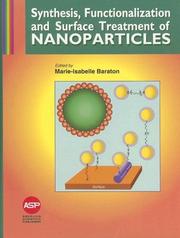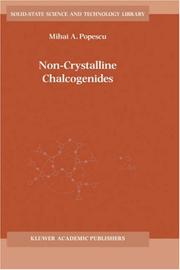| Listing 1 - 2 of 2 |
Sort by
|

ISBN: 1588830098 9781588830098 Year: 2003 Publisher: Stevenson Ranch American scientific publ.
Abstract | Keywords | Export | Availability | Bookmark
 Loading...
Loading...Choose an application
- Reference Manager
- EndNote
- RefWorks (Direct export to RefWorks)
Nanostructured materials. --- Nanoparticles. --- Composite materials. --- Chimie des surfaces. --- Nanoparticules. --- Composite materials --- Nanoparticles --- Nanostructured materials --- Surface chemistry --- Chemistry, Surface --- Interfaces, Chemistry of --- Surface phenomena --- Surfaces (Chemistry) --- Nanomaterials --- Nanometer materials --- Nanophase materials --- Nanostructure controlled materials --- Nanostructure materials --- Ultra-fine microstructure materials --- Composites (Materials) --- Multiphase materials --- Reinforced solids --- Solids, Reinforced --- Two phase materials --- Chemistry, Physical and theoretical --- Capillarity --- Surface energy --- Surface tension --- Surfaces (Physics) --- Microstructure --- Nanotechnology --- Nano-particles --- NPs (Nanoparticles) --- Particles --- Materials --- Nanoscale particles

ISBN: 0792366484 1280206845 9786610206841 0306471299 Year: 2000 Publisher: Dordrecht Kluwer
Abstract | Keywords | Export | Availability | Bookmark
 Loading...
Loading...Choose an application
- Reference Manager
- EndNote
- RefWorks (Direct export to RefWorks)
The earliest experimental data on an oxygen-free glass have been published by Schulz-Sellack in 1870 [1]. Later on, in 1902, Wood [2], as well as Meier in 1910 [3], carried out the first researches on the optical properties of vitreous selenium. The interest in the glasses that exhibit transparency in the infrared region of the optical spectrum rose at the beginning of the twentieth century. Firstly were investigated the heavy metal oxides and the transparency limit was extended from (the case of the classical oxide glasses) up to wavelength. In order to extend this limit above the scientists tried the chemical compositions based on the elements of the sixth group of the Periodic Table, the chalcogens: sulphur, selenium and tellurium. The systematic research in the field of glasses based on chalcogens, called chalcogenide glasses, started at the middle of our century. In 1950 Frerichs [4] investigated the glass and published the paper: “New optical glasses transparent in infrared up to 12 . Several years later he started the study of the selenium glass and prepared several binary glasses with sulphur [5]. Glaze and co-workers [6] developed in 1957 the first method for the preparation of the glass at the industrial scale, while Winter-Klein [7] published reports on numerous chalcogenides prepared in the vitreous state.
Chalcogenides --- Chalkogenides --- Inorganic compounds --- Chalcogenides. --- Lead chalcogenides. --- Materials science. --- Condensed matter. --- Optical materials. --- Electronic materials. --- Materials Science. --- Ceramics, Glass, Composites, Natural Methods. --- Condensed Matter Physics. --- Optical and Electronic Materials. --- Optics, Lasers, Photonics, Optical Devices. --- Characterization and Evaluation of Materials. --- Surfaces (Physics). --- Ceramics, Glass, Composites, Natural Materials. --- Physics --- Surface chemistry --- Surfaces (Technology) --- Optics --- Materials --- Ceramics. --- Glass. --- Composites (Materials). --- Composite materials. --- Lasers. --- Photonics. --- Material science --- Physical sciences --- New optics --- Light amplification by stimulated emission of radiation --- Masers, Optical --- Optical masers --- Light amplifiers --- Light sources --- Optoelectronic devices --- Nonlinear optics --- Optical parametric oscillators --- Electronic materials --- Condensed materials --- Condensed media --- Condensed phase --- Materials, Condensed --- Media, Condensed --- Phase, Condensed --- Liquids --- Matter --- Solids --- Composites (Materials) --- Multiphase materials --- Reinforced solids --- Solids, Reinforced --- Two phase materials --- Amorphous substances --- Ceramics --- Glazing --- Ceramic technology --- Industrial ceramics --- Keramics --- Building materials --- Chemistry, Technical --- Clay
| Listing 1 - 2 of 2 |
Sort by
|

 Search
Search Feedback
Feedback About
About Help
Help News
News